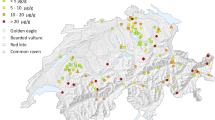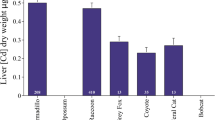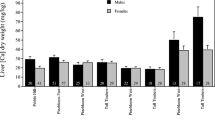Abstract
Voles and small passerine birds were live-captured near the Delong Mountain Regional Transportation System (DMTS) haul road in Cape Krusenstern National Monument in northwest Alaska to assess metals exposure and sub-lethal biological effects. Similar numbers of animals were captured from a reference site in southern Cape Krusenstern National Monument for comparison. Histopathological examination of selected organs, and analysis of cadmium, lead, and zinc concentrations in liver and blood samples were performed. Voles and small birds captured from near the haul road had about 20 times greater blood and liver lead concentrations and about three times greater cadmium concentrations when compared to those from the reference site, but there were no differences in zinc tissue concentrations. One vole had moderate metastatic mineralization of kidney tissue, otherwise we observed no abnormalities in internal organs or DNA damage in the blood of any of the animals. The affected vole also had the greatest liver and blood Cd concentration, indicating that the lesion might have been caused by Cd exposure. Blood and liver lead concentrations in animals captured near the haul road were below concentrations that have been associated with adverse biological effects in other studies; however, subtle effects resulting from lead exposure, such as the suppression of the activity of certain enzymes, cannot be ruled out for some individual animals. Results from our 2006 reconnaissance-level study indicate that overall, voles and small birds obtained from near the DMTS road in Cape Krusenstern National Monument were not adversely affected by metals exposure; however, because of the small sample size and other uncertainties, continued monitoring of lead and cadmium in terrestrial habitats near the DMTS road is advised.
Similar content being viewed by others
References
Alaska Department of Environmental Conservation (2007). Contaminated sites program, Red Dog Mine. Accessed February, 2008, at http://www.dec.state.ak.us/spar/csp/sites/reddog.htm#info.
Anderson, B. (1994). Sparrows. In Wildlife notebook series. Alaska Department of Fish and Game. Accessed March, 2008 at http://www.adfg.state.ak.us/pubs/notebook/notehome.php.
Baos, R., Jovani, R., Pastor, N., Tella, J. L., Jimenez, B., Gomez, G., et al. (2006). Evaluation of genotoxic effects of heavy metals and arsenic in wild nestling white storks (Ciconia ciconia) and black kites (Milvus migrans) from southwestern Spain after a mining accident. Environmental Toxicology and Chemistry, 25, 2794–2803.
Beyer, W. N., Connor, E. E., & Gerould, S. (1994). Estimates of soil ingestion by wildlife. Journal of Wildlife Management, 58, 375–382.
Beyer, W. N., Dalgarn, J., Dudding, S., French, J. B., Mateo, R., Miesner, J., et al. (2004). Zinc and lead poisoning in wild birds in the tri-state mining district (Oklahoma, Kansas, and Missouri). Archives of Environmental Contamination and Toxicology, 48, 108–117.
Bickham, J. W. (1990). Flow cytometry as a technique to monitor the effects of environmental genotoxins on wildlife populations. In S. S. Sandhu, W. R. Lower, F. J. de Serres, W. A. Suk, & R. R. Tice (Eds.), In situ evaluations of biological hazards of environmental pollutants (pp. 97–108). New York: Plenum.
Brumbaugh, W. G., Mora, M. A., & May, T. W. (2008). Assessment of metals exposre and sub-lethal effects in voles and small birds captured near the Delong Mountain Regional Transportation System Road, Cape Krusenstern National Monument, Alaska, 2006. U.S. Geological Survey Scientific Investigations Report 2008–5211, 21 pp.
Cook, J. A., & Johnson, M. S. (1996). Cadmium in mammals. In W. N. Beyer, G. H. Heinz, & A. W. Redmond-Norwood (Eds.), Environmental contaminants in wildlife: Interpreting tissue concentrations (pp. 377–388). Boca Raton: Lewis.
Custer, T. W., Bickham, J. W., Lyne, T. B., Lewis, T., Ruedas, L. A., Custer, C. M., et al. (1994). Flow cytometry for monitoring contaminant exposure in black-crowned night-herons. Archives of Environmental Contamination and Toxicology, 27, 176–179.
Custer, C. M., Custer, T. W., Archuleta, A. S., Coppock, L. C., Swartz, C. D., & Bickham, J. W. (2002). A mining-impacted stream: Exposure and effects of lead and other trace elements on tree swallows (Tachycineta bicolor) nesting in the upper Arkansas River Basin, Colorado. In D. J. Hoffman, B. A. Rattner, G. A. Burton Jr., and J. Cairns Jr., (Eds.), Handbook of ecotoxicology (2nd ed., pp. 755–764). Washington, DC: CRC.
Damek-Poprawa, M., & Sawicka-Kapusta, K. (2003). Damage to the liver, kidney, and testis with reference to burden of heavy metals in yellow-necked mice from areas around steelworks and zinc smelters in Poland. Toxicology, 186, 1–10.
Dieter, M. P. (1979). Blood δ-aminolevulinic acid dehydratase (ALA-D) to monitor lead contamination in canvasback ducks (Aythya valisineria). In Animals as monitors of environmental pollution (pp. 177–191). Washington, DC: National Academy Press.
Exponent (2007). DMTS fugitive dust risk assessment, Vol. 1—Final report. Prepared for Teck Cominco Alaska, Incorporated, November 2007. Accessed February 2008 at http://www.dec.state.ak.us/spar/csp/sites/reddog.htm#info.
Ford, J., & Hasselbach, L. (2001). Heavy metals in mosses and soils on six transects along the Red Dog Mine Haul Road, Alaska. NPS/AR/NRTR-2001/38. Accessed January 2008 at http://www.state.ak.us/dec/spar/csp/docs/reddog/reddogrpt2.pdf.
Franson, J. C. (1996). Interpretation of tissue lead residues in birds other than waterfowl. In W. N. Beyer, G. H. Heinz, & A. W. Redmond-Norwood (Eds.), Environmental contaminants in wildlife: Interpreting tissue concentrations (pp. 265–280). Boca Raton: Lewis.
Friend, M., & Franson, J. C. (1999). Field manual of wildlife diseases: General field procedures and diseases of birds. U.S. Geological Survey, Biological Resources Division, Information and Technology Report 1999–001, Washington, D.C.
Furness, R. W. (1996). Cadmium in birds. In W. N. Beyer, G. H. Heinz, & A. W. Redmon-Norwood (Eds.), Environmental contaminants in wildlife: Interpreting tissue concentrations (pp. 389–404). Boca Raton: Lewis.
Gannon, W., & Sikes, R. S. (2007). Guidelines of the American Society of Mammalogists for the use of wild animals in research. Journal of Mammalogy, 88, 809–823.
Garland, T. (2007). Zinc. In R. C. Gupta (Ed.), Veterinary toxicology: Basic and clinical principles (pp. 470–472). London: Elsevier.
Getz, L. L., Best, L. B., & Prather, M. (1977). Lead in urban and rural song birds. Environmental Pollution, 12, 235–238.
Hartwig, A. (1994). Role of DNA repair inhibition in lead- and cadmium-induced genotoxicity: A review. Environmental Health Perspectives, 102, 45–50.
Hartwig, A. (1995). Current aspects in metal genotoxicity. Biometals, 8, 3–1.
Hasselbach, L., Ver Hoef, J. M., Ford, J., Neitlich, P., Crecelius, E., Berryman, S., et al. (2005). Spatial patterns of cadmium and lead deposition on and adjacent to National Park Service lands near Red Dog Mine, Alaska. Science of the Total Environment, 348, 211–238.
Hooser, S. B. (2007). Cadmium. In R. C. Gupta (Ed.), Veterinary toxicology: Basic and clinical principles (pp. 422–426). London: Elsevier.
Johnson, G., Audet, D. J., Kern, J. W., LeCaptain, L. J., Strickland, D. M., Hoffman, D. J., et al. (1999). Lead exposure in passerines inhabiting lead-contaminated floodplains in the Coeur D’Alene River Basin, Idaho, USA. Environmental Toxicology and Chemistry, 18, 1190–1194.
Knox, A. G., & Lowther, P. E. (2008). Common redpoll (Carduelis flammea). In A. Poole (Ed.), The birds of North America Online: Ithaca. Cornell Laboratory of Ornithology. Accessed February 2008 at http://bna.birds.cornell.edu/bna/species/543/articles/introduction.
Ma, W.-C. (1996). Lead in mammals. In W. N. Beyer, G. H. Heinz, & A. W. Redmond-Norwood (Eds.), Environmental contaminants in wildlife: Interpreting tissue concentrations (pp. 281–296). Boca Raton: Lewis.
Ma, W.-C., Denneman, W., & Faber, J. (1991). Hazardous exposure of ground-living small mammals to cadmium and lead in a contaminated terrestrial ecosystem. Archives of Environmental Contamination and Toxicology, 20, 266–270.
MacDonald, S. O., & Cook, J. A. (2002). Mammal inventory of Alaska’s National Parks and Preserves, Northwest Network, Western Arctic Parklands, Annual Report 2001. Accessed February 2008 at http://www1.nature.nps.gov/imy/units/AKRO/Documents/Inventory_Reports/mamm_nwan_01.pdf.
McBride, T. J. (2007). Influence of metal mixtures on co-occurring toxic metal bioavailability and effects in adult and developing deer mice. PhD dissertation, Texas Tech University, December, 2007.
Munson, L. (2007). Necropsy of wild animals. http://www.vetmed.ucdavis.edu/whc/pdfs/munsonnecropsy.pdf. Last accessed: 20 August 2009.
Naugler, C. T. (1993). American tree sparrow (Spizella arborea). In A. Poole (Ed.), The birds of North America online: Ithaca. Cornell Laboratory of Ornithology. Accessed February 2008 at http://bna.birds.cornell.edu/bna/species/543/articles/introduction.
Ornithological Council (1999). Guidelines to the use of wild birds in research. In A. S. Gaunt, & L. W. Oring (Eds.), The Ornithological Council, Washington, D.C., 66 pp.
Osborne, T. (1994). Voles. In Wildlife notebook series. Alaska Department of Fish and Game. Accessed March 2008 at http://www.adfg.state.ak.us/pubs/notebook/notehome.php.
Pain, D. J. (1996). Lead in waterfowl. In W. N. Beyer, G. H. Heinz, & A. W. Redmond-Norwood (Eds.), Environmental contaminants in wildlife: Interpreting tissue concentrations (pp. 251–264). Boca Raton: Lewis.
Phalen, D. N. (2003). The avian necropsy. Veterinary Quarterly Review, 19, 4–6.
Reynolds, K. D., Schwarz, M. S., McFarland, C. A., Strauss, R. E., McBride, T. J., Cobb, G. P., et al. (2006). Northern pocket gophers (Thomomys talpoides) as biomonitors of environmental metal contamination. Environmental Toxicology and Chemistry, 25, 458–469.
Saggese, M. D., Riggs, G., Tizard, I., Bratton, G., Taylor, R., & Phalen, D. N. (2007). Gross and microscopic findings and investigation of the aetiopathogenesis of mycobacteriosis in a captive population of white-winged ducks (Cairina scutulata). Avian Pathology, 36, 415–422.
SAS Institute, Inc. (2004). SAS/STAT® 9.1 user’s guide. Cary, North Carolina, USA.
Scheuhammer, A. M. (1987). The chronic toxicity of aluminum, cadmium, mercury, and lead in birds: A review. Environmental Pollution, 46, 263–295.
Schmidt, R., Reavell, D., & Phalen, D. N. (2003). Pathology of exotic birds. Ames: Iowa State University Press.
Schmitt, C. J., Blazer, V. S., Dethloff, G. M., Tillitt, D. E., Gross, T. S., Bryant, Jr., W. L., et al. (1999). Biomonitoring of Environmental Status and Trends (BEST) Program: Field procedures for assessing the exposure of fish to environmental contaminants. U.S. Geological Survey, Biological Resources Division, Columbia, (MO): Information and Technology Report USGS/BRD-1999-0007. iv + 35 pp. + appendices.
Sharma, A., & Taludker, G. (1987). Effects of metals on chromosomes of higher organisms. Environmental Mutagenesis, 9, 191–226.
Shore, R. F., & Rattner, B. A. (Eds.) (2001). Ecotoxicology of wild mammals (752 pp.). Chichester: Wiley.
Sileo, L., Beyer, W. N., & Mateo, R. (2004). Pancreatitis in wild zinc-poisoned waterfowl. Avian Pathology, 32, 655–660.
Stansley, W., & Roscoe, D. E. (1996). The uptake and effects of lead in small mammals and frogs at a trap and skeet range. Archives of Environmental Contamination and Toxicology, 30, 220–226.
Talmage, S. S., & Walton, B. T. (1991). Small mammals as monitors of environmental contaminants. Reviews in Environmental Contamination and Toxicology, 119, 47–145.
Thompson, L. J. (2007). Lead. In R. C. Gupta (Ed.), Veterinary toxicology: Basic and clinical principles (pp. 422–426). London: Elsevier.
U.S. Environmental Protection Agency (1993). Wildlife exposure factors handbook. U.S. Environmental Protection Agency, Office of Health and Environmental Assessment and Office of Research and Development, EPA/600/R-93/187. Accessed February 2008 at http://cfpub.epa.gov/ncea/cfm/wefh.cfm.
U.S. Environmental Protection Agency (1996). Guidance on the documentation and evaluation of trace metals data collected for clean water act compliance monitoring. EPA 821-B-96–002, Office of Water, Washington, D.C., 32 pp.
U.S. Fish and Wildlife Service (1986). Use of lead shot for hunting migratory birds in the United States, final environmental impact statement: FES 86–16. Washington, D.C.: U.S. Fish and Wildlife Service.
Wheelwright, N. T., & Rising, J. D. (1993). Savannah Sparrow (Passerculus sandwichensis). In A. Poole (Ed.), The birds of North America Online: Ithaca. Cornell Laboratory of Ornithology. Accessed February 2008 at http://bna.birds.cornell.edu/bna/species/045/articles/introduction.
Author information
Authors and Affiliations
Corresponding author
Rights and permissions
About this article
Cite this article
Brumbaugh, W.G., Mora, M.A., May, T.W. et al. Metal exposure and effects in voles and small birds near a mining haul road in Cape Krusenstern National Monument, Alaska. Environ Monit Assess 170, 73–86 (2010). https://doi.org/10.1007/s10661-009-1216-y
Received:
Accepted:
Published:
Issue Date:
DOI: https://doi.org/10.1007/s10661-009-1216-y




